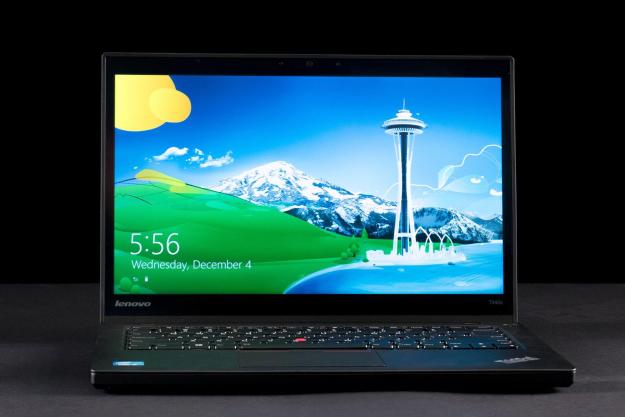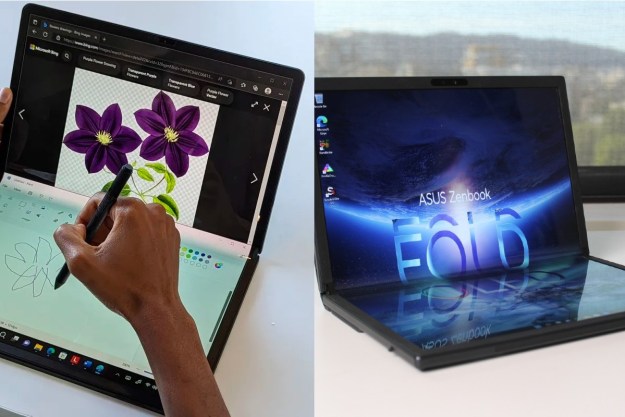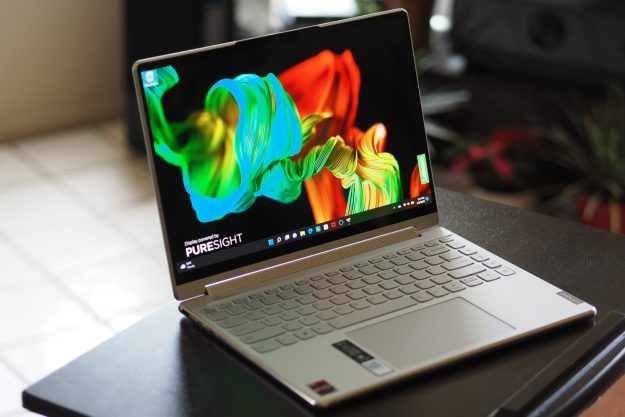
“While worthy of the ThinkPad name, mediocre design and a troublesome touchpad keep the T440s just short of greatness.”
- Great keyboard
- Decent 1080p touchscreen
- Can run up to 28 hours on optional 6-cell battery
- Some materials feel cheap
- Poor audio quality
- Frustrating touchpad
- Mediocre value
The last few years have seen the release of the first truly touch-centric Windows operating system, the introduction of incredibly efficient Intel 4th-gen processors, and the rise of the tablet, all of which has encouraged change in the laptop market. Lenovo has been among the quickest to adapt, and for its speed, it has been rewarded with sky-rocketing market share.
Not all consumers embrace change though. Buyers of business notebooks are among the most stubborn. These die-hard fans of productivity and power react to new features with skepticism at best, and hatred at worst. Despite this, Lenovo has decided its ThinkPad lineup needs a refresh, and has changed many of the brand’s iconic traits.
The new ThinkPad T440s is a summary of the brand’s redirection. Instead of a matte display, the T440s employs a semi-gloss coating. The old-fashioned beveled keyboard has been replaced by the more modern, island-style “AccuType” design. The touchpad no longer has discrete buttons, and a multi-touch screen is available as an option.
In short, the new T440s bears little resemblance to the T420s we reviewed and awarded with an Editor’s Choice in February 2012. But is the T440s worse now, or is it an improvement of an already excellent recipe?
Subtle changes to the ThinkPad look
There’s no mistaking the T440s for anything other than a ThinkPad, and not just because of the large “ThinkPad” logos found on both the display lid and the palmrest. The matte-black coating is similar to all the previous models, and the blocky design screams “I’m all business.”
Yet there are also significant differences with the T440s which the ThinkPad faithful will most certainly notice. While the chassis is made of carbon fiber and magnesium, these materials have a smoother, somewhat glossy coat instead of the rough texture found on previous models. The display bezel, traditionally large on ThinkPads, has shrunk to a half-inch on the sides and about three-quarters of an inch along the top. And the grippy semi-soft surfacing used on the lid of older models has made an exit, replaced with a smoother finish.

Whether these changes are a boon or outright heresy will depend on your perspective, but there is one area where the T440s has undisputedly improved; size. While the “s” line of the T-series has always been marketed as a slimmer, lighter ThinkPad, it was actually a bit bulky when compared to other ultrabooks. That’s no longer true. The new model weighs just 3.5 pounds, is eight-tenths of an inch thick, and only 13 inches wide.
Unlike a consumer notebook, which usually tapers towards the front to enhance the perception of thinness, this ThinkPad is equally thick throughout. This allows it to offer three USB ports, all of them 3.0, along with DisplayPort, VGA, Ethernet and a card reader. A combo headphone/microphone jack is also included. This array of connectivity is better than average and the inclusion of VGA makes output to analog displays and projectors possible – a big plus for business travelers.
Two experiments, one failure
The theme of change continues with the keyboard and touchpad, both of which embrace Lenovo’s new design direction. Beveled keys have been replaced by the “AccuType” keyboard, which features an island-style layout. The keys are not flat, however. Instead, they’re slightly indented and curved at their bottom edge, a trait that improves key feel and makes touch-typing easier. Though different, the new keyboard is among the best available today.
The T440s represents a new direction for the ThinkPad, but whether it’s a better direction is hard to say.
Backlighting is standard and activated via a function hotkey. There are only two brightness settings, however, and the brightest of the pair is too brilliant for use in a dark room. Small key caps make light leak an issue, too, as some LEDs are visible underneath the keys during normal use. This is distracting and robs the T440s of the premium look a quality backlight normally provides.
While the trackpointer remains, Lenovo has made significant changes to the touchpad, which has abandoned all discrete buttons in favor of a single, clickable surface. In theory, this is a sensible move because it almost doubles the touchpad’s size, which is now four inches wide and three inches deep. However, execution falls short of potential.
The touchpad’s surface is loosely sprung, unsteady and feels bit cheap. To make matters worse, our review unit seemed confused about what we wanted to do at times. The cursor wandered, multi-touch inputs we didn’t make were registered and clicks sometimes took a few tries before they were accepted. Simply put, the T440s has the worst touchpad we’ve used all year.
Glossy, but is that a bad thing?
ThinkPads have traditionally shipped with a matte coating that cut down on glare but also severely hampered image quality. That was tolerable when glossy competitors also offered bad displays, but times have changed. In response to this reality, the new T440s has switched to a semi-gloss coat.
While this means reflections are visible, a bright backlight helps to reduce the problems caused by glare, and in most rooms the display can be comfortably used at 50% to 70% of its maximum brightness. Direct sunlight, however, will greatly diminish visibility.

In exchange for reflections, the new semi-gloss coat provides exactly the benefits we hoped to see. Our review unit’s 1080p touchscreen proved capable of rendering 97% of the sRGB gamut while maintaining a contrast ratio of 720:1 with the backlight at 100%. Subjectively, this results in an image that provides an excellent sense of depth when viewing images, games and movies, and it’s a huge improvement over the washed-out look of older ThinkPads.
The built-in speakers remain a problem, however. Though serviceable for basic tasks like video conferencing, they quickly become muddled by music and movies. Quality is acceptable at up to three-fourths of maximum volume, but also too quiet to overcome moderate ambient noise. Pushing volume higher only muddies the mid-range and induces distortion whenever the speakers try to produce bass.
Sufficient power
Our review unit arrived with an Intel Core i5-4200U, a mid-range processor which is also the most basic option available with the T440s. Despite this, the laptop turned in respectable performance marks, managing a score of 38.69 GOPS in SiSoft Sandra’s Processor Arithmetic benchmark and 7,277 MIPs in the combined 7-zip decompression/compression test.
The semi-gloss display provides a huge improvement over the washed-out look of older ThinkPads.
These numbers are average for the ultrabook category and more than adequate for most users. Dell’s XPS 12, one of our recent favorites, scored 38.5 GOPS in SiSoft Sandra and 6,888 MIPs in 7-Zip, while the Lenovo Flex managed respective scores of 38 GOPS and 7,087 MIPs.
A 500GB mechanical drive is standard, but our unit was equipped with a 128GB solid state drive. This allowed the T440s to achieve a PCMark 8 storage score of 4,945, which is again an average score for an ultrabook. Other recently tested competitors, including the Dell XPS 12, Lenovo Flex and ASUS Zenbook UX301, scored between 4,800 and 5,000.
Graphics performance comes courtesy of Intel’s HD 4400 GPU, which managed a score of 3861 in the 3DMark Cloud Gate test, but only returned a figure of 463 in the more demanding Fire Strike test. These results translate to passable performance in older titles, but new 3D games will struggle to play at 1080p. The T440s is a bit behind the curve when is graphics performance is compared to competitors; Toshiba’s Tecra Z40 managed a score of 4,294 in Cloud Gate, for example, while the Dell XPS 12 scored 4,281 in the same test.
A plethora of batteries
While most modern laptops come with a single built-in battery, the T440s is more complex. A small 3-cell battery rated at 23.5 watt-hours is built into the chassis, and it can be paired with either another 3-cell battery of the same size or a larger 6-cell unit that provides an impressive 72 watt-hours of juice. The larger model juts out from the laptop’s bottom, however, and adds a few tenths of a pound to its weight. Strangely, upgrading to the larger battery costs only five dollars, but buying it as an accessory will set you back about $140.
You may not need to spend even that, however, because the basic 3-cell+3-cell combo provides excellent endurance. The Peacekeeper browser benchmark needed six hours and forty-one minutes to drain a full charge, just two minutes short of the record-holding Dell XPS 12. Our light-load Reader’s Test, which simulates offline document viewing, extended endurance to eight hours and twenty-five minutes.

Attaching the six-cell battery boosted results well into record-breaking territory. With it installed, the T440s lasted 14 hours and 32 minutes in the Peacekeeper web browsing benchmark and over twenty-eight hours in the Reader’s Test. And, because of the internal battery, it’s possible to hot-swap a new battery once the previous drains.
Power draw is low, as well. Our watt-meter recorded just 10 watts of draw at idle with the display at maximum brightness and no more than 29 watts of draw at full load. These are solid results that make the most of the many watt-hours that the batteries provide.
Efficient and cool
Though both slim and reasonably quick, the T440s never strained to cool itself during our tests. We registered a maximum external temperature of 91.5 degrees Fahrenheit at full processor load. At idle, that figure sank down to 84.3 degrees. This wasn’t the result of an over-active fan, either, because we never recorded more than 41.8 decibels of fan noise. Such cool, quiet operation makes this ThinkPad easy to coexist with.
Subtle software
While Lenovo hasn’t dropped its software suite from Lenovo
The T440s has the worst touchpad we’ve used all year.
This is mostly because there simply aren’t as many as there used to be. The power manager and WiFi software that used to be standard are now missing, and the Solution Center can only perform the most basic checks on system resources. An optional biometric security system, which works in conjunction with a fingerprint reader embedded in the laptop, is present though.
Aside from that, the T440s comes with only a few third-party apps installed. Among them is Norton Internet Security which, as usual, annoys the user with constant pop-ups until it is purchased or un-installed.
Conclusion
There’s no doubt that the T440s represents a new direction for the ThinkPad line, but whether it’s a better direction is harder to say. In some areas, such as size, weight and display quality, this new ThinkPad is clearly superior to its older siblings. Other aspects, such as the touchpad and material quality, are a step back.
But there’s more to compare the T440s to than itself. The base price for this laptop starts just south of $1,000 and, when equipped like our review unit, that figure rises to about $1,300 ($1,180 if you don’t buy the 6-cell and 3-cell batteries). That puts the ThinkPad in a league which includes the Dell XPS 13 and MacBook Pro 13 with Retina, two excellent choices for consumers and business travelers alike.
Unfortunately, when compared to these kings of the ultrabook market, Lenovo’s latest and greatest falls a bit short. The display, though better than past ThinkPads, still lags behind the best, and both the XPS 13 and MacBook Pro 13 offer a clearly superior touchpad.
The Lenovo ThinkPad T440s does have strengths though. The keyboard is excellent, performance is competitive, and battery life is good with the 3-cell battery and record-breaking with the bulbous 6-cell. These traits should make it popular with road warriors and frequent fliers, but the average consumer has better options to choose from.
Highs
- Great keyboard
- Decent 1080p touchscreen
- Can run up to 28 hours on optional 6-cell battery
Lows
- Some materials feel cheap
- Poor audio quality
- Frustrating touchpad
- Mediocre value
Editors' Recommendations
- Best Lenovo laptop deals: Save on Yoga and ThinkPad laptops
- The best Lenovo laptops for 2023: ThinkPad, Yoga, and more
- The ThinkPad X1 Carbon Gen 11 is both faster and longer-lasting
- Lenovo’s latest ThinkPad Z13 includes a lid made entirely of flaxseeds
- The ThinkPad X1 laptop line embraces recycled magnesium and aluminum


